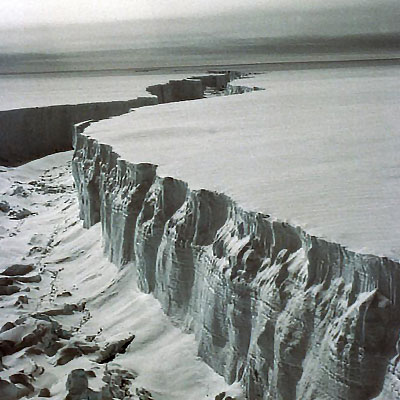
The climate of the future
Ice Shelves are large extensions of continental ice which acts as a barrier between the ice on the land, and the ocean. They are critical in supporting the ice on land from flowing into the sea. However, rising temperatures are causing irreversible changes to these icy features.
The Larsen B and C ice shelves on the Antarctic Peninsula are some of the most well-known ice shelves in Antarctica. Play the Newsflash and read the summary below about the collapse of Larsen B in 2002, and then scroll down to find out about what is happening at Larsen C.
Larsen B Ice Shelf
“In 2002, the Larsen B ice shelf broke away from the Antarctic Peninsula. Five hundred billion tonnes of ice floated off into the sea, breaking up into thousands of icebergs. This collapse dumped more ice into the Southern Ocean than all the icebergs over the previous fifty years put together. Elsewhere, satellite images have revealed that the West Antarctic ice sheet is thinning and may even collapse in the future.
Many scientists believe that the thinning ice is a sign of global warming. In the last fifty years the Antarctic Peninsula has warmed by 2.50°C, faster than anywhere else on Earth, and temperatures are now at their highest for 1,800 years.
The collapse of ice shelves like Larsen B may have a knock-on effect on the glaciers that flow from Antarctica’s ice sheets. A team working for the British Antarctic Survey (BAS) studied hundreds of aerial and satellite images of the Antarctic Peninsula dating back to the 1940s. Scientists are very worried at how quickly this has happened, and some say it is a wake-up call to the world to do something.”
The cinemagraph below shows the collapse of the Larsen B ice shelf in 2002. The unusually rapid disintegration occurred due to a series of warm summers on the Antarctic Peninsula, warm ocean temperatures in the Weddell Sea, and fracturing from surface melt ponds.


Larsen C Ice Shelf
Larsen C is one of the largest ice shelves on the Antarctic Peninsula. However, just like Larsen B which we have just heard about, it has experienced extreme stress because of climate change. Whilst Larsen B has completely disintegrated, Larsen C remains. However, in July of 2017, a 6,000km2 iceberg, (which is approximately the size of Luxembourg) calved off into the ocean. This iceberg is known as A-68.
Because the ice was already floating on water, it did not contribute anything directly to sea level rise, however scientists are concerned that if other icebergs of this size calves off into the ocean, then the ice on land will become unstable and rapidly retreat. This would then cause changes to global sea level.
Activity
-
Pick out ten key words or phrases from the newsflash that sum up the main messages.
-
Compare your words or phrases to your neighbour – did you come up with similar ones?
-
Download the information sheet ‘Warning signs‘ to find out more







